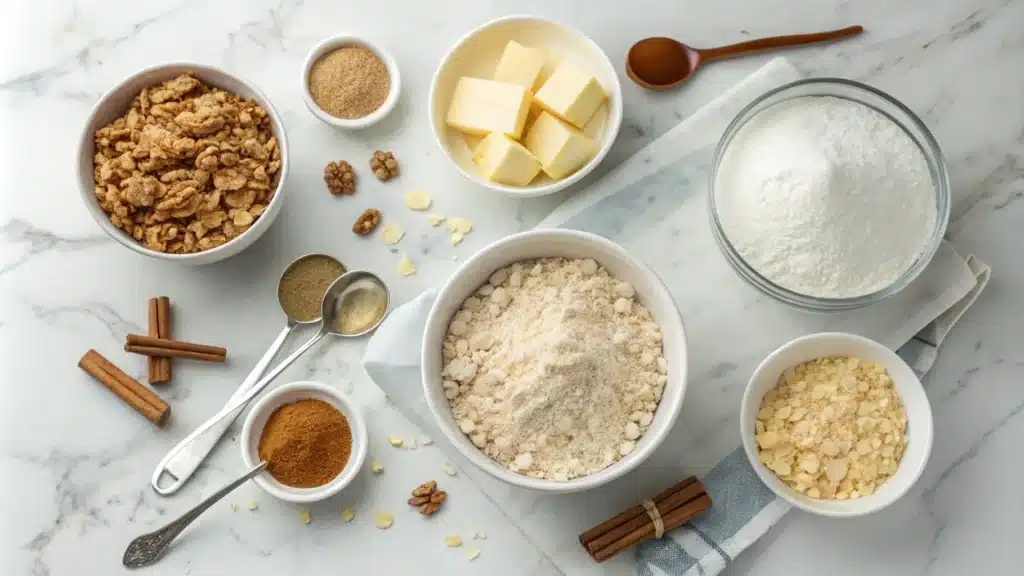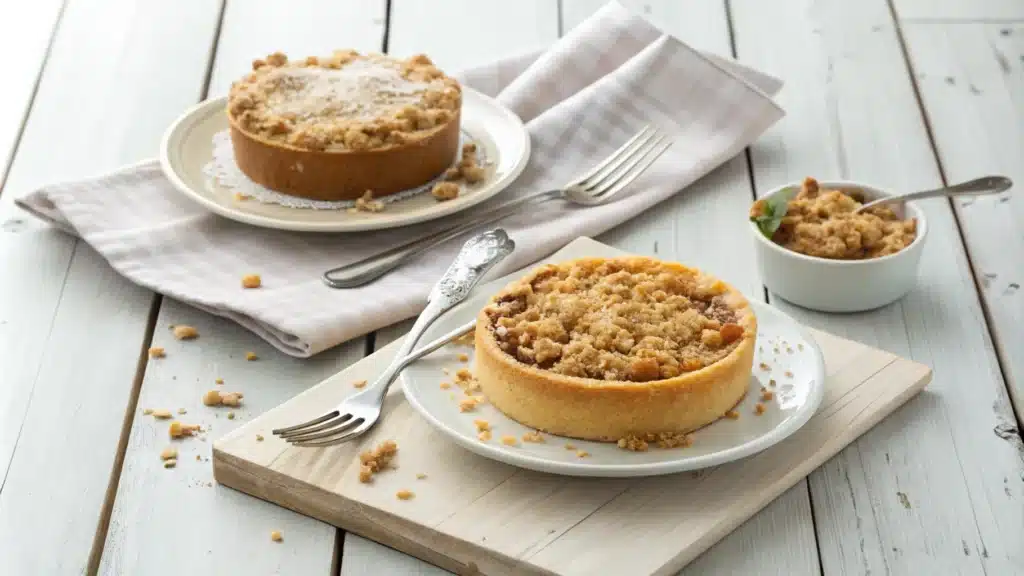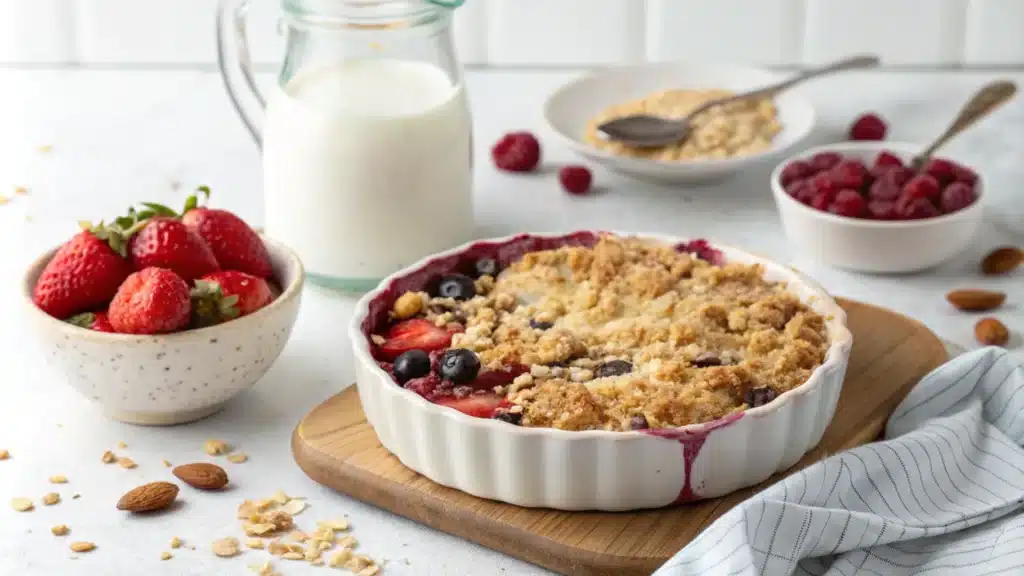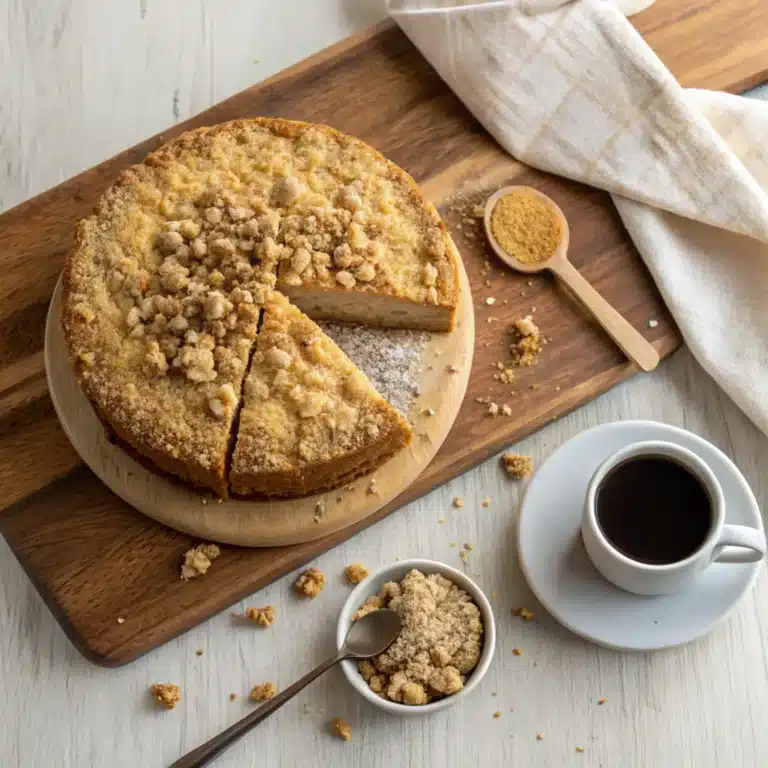When it comes to desserts, toppings often take center stage. Two favorites are crumble and streusel. While they may seem similar, they have their own textures, flavors, and histories. Many people mix them up, but these two toppings are quite different and deserve attention.
This article discover s crumble and streusel—their origins, ingredients, and uses. We examine their textures and cultural significance to highlight what makes each one unique. Whether you bake often or are simply curious, discover what sets these two dessert toppings apart
Table of contents
Introduction to Crumble and Streusel
Definition of Crumble and Streusel
Crumble and streusel are popular dessert toppings that bring flavor and texture to sweets. While they might look similar, they use different ingredients and methods. Crumble, as the name suggests, is a chunky topping with a rustic look. You make it by mixing flour, butter, and sugar, and it’s often added to baked fruit desserts like crisps and cobblers for a buttery crunch
On the other hand, streusel comes from the German word for “sprinkle” or “strewn.” This topping is slightly finer in texture and typically includes ingredients like cinnamon, nuts, or even oats for added flavor. Streusel is commonly used on coffee cakes, muffins, and pastries, giving baked goods a rich, crumbly finish.
Overview of Key Differences
The main difference between crumble and streusel is their texture and use. Crumble is chunkier and only used as a topping, while streusel can be baked into desserts, serving as both a topping and a flavor booster. Streusel often includes spices or nuts, adding more complex flavors.
Both toppings are simple to make but appeal to different tastes and baking styles.
Origins and Cultural Background
The History Behind Crumble vs. Streusel
Streusel traces its origins back to Germany, where the word itself means “sprinkle” or “strewn.” This name reflects its traditional preparation—crumbly bits of dough sprinkled generously over baked goods. In Germany, streusel has been a hallmark of classic desserts, especially coffee cakes, buns, and danishes. The topping’s combination of sugar, flour, and butter, often enriched with spices like cinnamon or added nuts, creates a rich, slightly crunchy layer that pairs beautifully with soft pastries.
Over the centuries, German immigrants brought streusel recipes to other parts of the world, particularly the United States. It became a beloved addition to American coffee cakes and muffins, celebrated for its versatility and ability to Improve even the simplest bakes. Today, streusel maintains its heritage as a European-inspired treat while remaining a favorite in global baking traditions.
Where Did Crumble and Streusel Come From?
Unlike streusel, crumble’s roots are firmly planted in British soil. This humble topping gained prominence during World War II when rationing limited access to ingredients like butter and sugar. Bakers created crumble as an economical alternative to traditional pie crusts, using flour, fat, and a touch of sugar to top baked fruits like apples, berries, or rhubarb.
Crumble quickly became a household staple in Britain, offering a no-fuss dessert that highlighted the natural sweetness of fruits. Over time, the dish evolved, and today it’s a favorite worldwide. Its charm lies in its simplicity and rustic texture, which pairs perfectly with fresh or cooked fruits.
Ingredients and Composition
Key Ingredients in Crumble and Streusel
Streusel is all about achieving a balance of sweetness and richness. The basic recipe includes flour, butter, and sugar, but it often gets a flavorful twist with spices like cinnamon or nutmeg. Some versions also incorporate oats, nuts, or even seeds, creating a topping that’s slightly crunchy yet tender. The butter is cut into the dry ingredients, forming a crumbly dough that’s easy to sprinkle over cakes or pastries.

What sets streusel apart is the fine texture achieved by working the butter into smaller pieces. This creates a delicate topping that bakes into a golden-brown layer, adding not just flavor but also a bit of crunch.
What Sets Crumble Apart from Streusel?
Crumble shares a similar ingredient base—flour, butter, and sugar—but it skips the spices and add-ins. The result is a chunkier, rustic topping that feels less refined but just as satisfying. Crumble is typically coarser than streusel because the butter is mixed in less thoroughly, leaving larger chunks that give it a rugged texture.
Another key difference is the focus on simplicity. While streusel may have layers of flavor complexity, crumble shines in its minimalist approach. Its purpose is to Improve the fruit below rather than steal the spotlight.
Techniques for Making Crumble vs. Streusel
The technique for making these toppings differs slightly. Streusel requires precision, with butter finely worked in to achieve that signature sandy texture. Crumble, on the other hand, is more forgiving—you can even make it by hand without much fuss. Variations exist for both, including gluten free or vegan options, but their distinct identities remain clear.
So, what’s the difference between crumble and streusel? It lies in the ingredients, technique, and texture, each tailored to their unique culinary roles.
Texture, Flavor, and Appearance
Texture Differences: Crispy vs. Crumbly
The textures of crumble and streusel couldn’t be more distinct, and understanding this difference is key to deciding which to use. Crumble is chunkier, with a coarse and uneven texture that feels rustic and homemade. This texture comes from leaving larger butter chunks in the dough, which melt during baking, creating pockets of crispness.
On the other hand, streusel is finer and smoother. The butter is more evenly incorporated, creating a topping that’s tender yet slightly crunchy. This finer consistency makes streusel ideal for pastries where a delicate topping is preferred.
Flavor Profiles: Sweet vs. Rich
The flavor difference comes down to ingredients and balance. Crumble is simple—sweet enough to match the fruit it tops, letting the main ingredients stand out.
Streusel adds more. It often includes spices like cinnamon or nutmeg and sometimes nuts or oats. These extras make streusel richer and more flavorful, perfect for pastries and cakes
Visual Appeal: The Look of Each Topping
Crumble looks chunkier and more uneven, giving desserts a rustic, homemade feel. Streusel, on the other hand, has a smoother and more polished look, adding a professional touch.
So, what’s the difference between crumble and streusel? Their texture, flavor, and appearance set them apart. Crumble’s rustic style contrasts with streusel’s elegant finish, letting bakers choose the right one for any occasion.

For more delicious dessert ideas, check out the Peach Crumble Recipe on Masterly Recipes.
Uses and Applications in Baking
Streusel in Classic Recipes
Streusel excels in baked goods where a buttery, sweet topping Improves the overall flavor. Coffee cakes are a classic example. The rich, slightly crunchy streusel layer provides a perfect contrast to the cake’s soft texture. It’s also a staple on muffins, danishes, and even sweet breads, where its rich flavors and fine crumb stand out.
Additionally, streusel can be baked into pastries, adding flavor throughout the dessert. Its versatility makes it a favorite among bakers, especially for breakfast or brunch treats.
Crumble’s Signature Role in Desserts
Crumble’s simple and chunky texture makes it perfect for fruit desserts like apple crumble, peach crisp, or rhubarb cobbler. Its rustic look works well with baked fruits, making a dessert that’s both comforting and tasty. As it bakes, the butter and sugar caramelize, creating a crispy topping that’s irresistible.
Unlike streusel, crumble rarely includes spices or extra ingredients, keeping the focus on the fruit. This makes it a go-to choice for highlighting seasonal produce or creating fuss free desserts.
So, what’s the difference between crumble and streusel? While streusel complements cakes and pastries with its refined sweetness, crumble shines in fruit forward desserts, offering a hearty and rustic touch.
For another crumble related recipe, discover the Peach Crumble vs. Peach Crisp Difference article for more insights.
Health and Nutritional Considerations
Caloric and Nutritional Content
When comparing crumble and streusel, their nutritional content varies depending on ingredients and portion sizes. Both toppings are calorie dense due to their high fat and sugar content. A typical streusel portion contains slightly more calories because it often includes add-ins like nuts or oats, which, while healthy, also add extra fat and carbohydrates.
Crumble, with its simpler ingredient list, usually has fewer calories per serving. However, both toppings are best enjoyed in moderation as part of a balanced diet. If you’re watching your intake, you might want to consider healthier substitutes, such as using whole grain flour or reducing the amount of butter.
Ingredient Modifications for Healthier Options
Good news! You can easily make either topping healthier without sacrificing taste. For streusel, consider using chopped nuts for added protein and fiber or swapping regular sugar for a natural sweetener like coconut sugar. For crumble, try replacing part of the flour with almond flour or incorporating oats for a nutrient boost.
So, what’s the difference between crumble and streusel nutritionally? Crumble is often a simpler, slightly lighter option, while streusel can pack a punch with its flavorful extras. Regardless of your choice, both can be tweaked to align with your health goals.
FAQs
Are Crumble and Streusel Interchangeable?
While crumble and streusel may seem similar, they are not always interchangeable. Crumble is chunkier and better suited for fruit based desserts like cobblers or crisps. Its coarse texture works perfectly with juicy fillings. Streusel, on the other hand, is finer and often enriched with spices, making it ideal for coffee cakes, muffins, and pastries. Substituting one for the other can change the texture and flavor balance of a dish.
Why Does My Streusel or Crumble Sink?
A sinking topping can be frustrating, but it’s usually caused by too much moisture in the batter or filling. To prevent this, Secure your butter is cold when preparing the topping, and avoid overmixing. For fruit desserts, use slightly less liquid in the filling, so the topping stays crisp.
Can You Make Gluten-Free or Vegan Versions?
Yes, both crumble and streusel can be adapted to meet dietary needs. For a gluten free option, substitute regular flour with almond or oat flour. For a vegan alternative, replace butter with plant based margarine or coconut oil. These swaps Secure everyone can enjoy these tasty toppings.

What’s the difference between crumble and streusel in terms of adaptability?
Both are very flexible, but streusel’s fine texture might need more care when changing ingredients. Still, you can easily adjust either topping to fit your taste.
For more baking tips and tricks, consider exploring related recipes on Masterly Recipes to expand your dessert repertoire.
What Makes Crumble Different from Streusel?
The most noticeable difference is texture. Crumble has a chunkier, more rugged feel due to its coarser preparation, while streusel is finer and more delicate. Streusel also tends to include extras like cinnamon, oats, or nuts, adding layers of flavor.
Yes, you can make both crumble and streusel ahead of time! Store them in the fridge for up to three days or freeze them in a sealed container for longer. Just thaw when needed, making it easy to whip up a dessert anytime.
Why Is My Topping Not Crispy?
A soft or soggy topping often happens when there’s too much moisture in the dessert. For crumble, Secure the butter is cold when mixed, and for streusel, avoid overmixing the ingredients. Also, keep an eye on baking times—underbaking can prevent the topping from crisping.
Which Topping Is Easier to Make?
Crumble is generally simpler to prepare since it doesn’t require precision or added ingredients. Streusel, with its spices and optional extras, takes a bit more attention but rewards bakers with a richer flavor profile.
Conclusion and Final Thoughts
Summing Up the Differences
So, what’s the difference between crumble and streusel?
Both are popular dessert toppings, but they have their own unique traits. Crumble is chunkier and has a rustic feel, perfect for fruit desserts with a simple, crunchy texture. Streusel is finer and more delicate, often made with spices or nuts, making it great for cakes and pastries
Whether you like the simple charm of crumble or the rich flavor of streusel, both make desserts more tasty and textured. Try using both to see which one works best for your baking
For more tips, check out Masterly Recipes’ Peach Crumble Recipe to see crumble in action!

